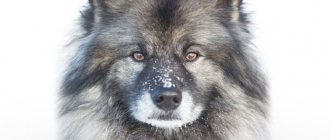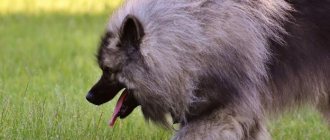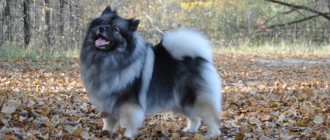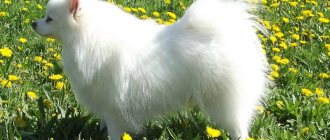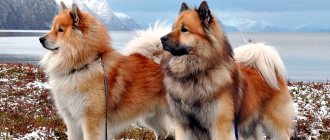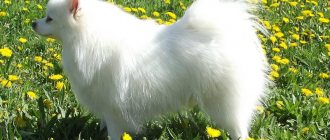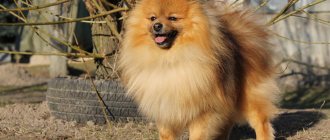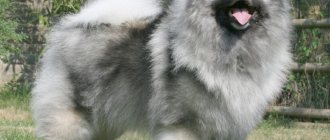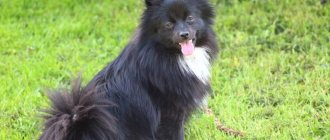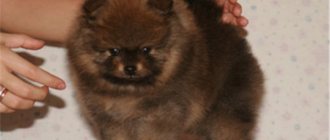History of the breed
The homeland of the Keeshond is Germany.
This species is one of the oldest breeds in the world. The main distribution of Wolfspitz dogs is observed in Germany and Holland, where they have been known for more than 400 years. It was here that these dogs were identified as a separate breed.
The ancestors of the Keeshond are prehistoric peat dogs and lake dogs dating back to the Neolithic. In Central Europe these are the most ancient breeds.
In the distant past, at the very beginning of the history of the breed, its representatives were called “barge dog”.
This is due to the fact that these animals were kept mainly on barges, boats and other vessels. Their duties included catching rodents.
In 1781, the barge dog was renamed Keeshond. During the same period, representatives of the breed gained great popularity. A civil uprising occurred. The revolution was led by Cornelius de Guislar. His favorite pet was a Wolfspitz.
The dog became the emblem of the revolution, a symbol of freedom. But the uprising was defeated. Those people who previously sympathized with Keeshonds and kept them in their homes hastily tried to get rid of their pets, fearing accusations of belonging to conspirators and revolutionaries.
As a result, the number of Wolfspitz catastrophically decreased over a short period of time. The breed was threatened with complete extinction.
The situation was saved by the intervention of Baroness von Hardenbruck. She really liked the friendly “smiling” dogs with wolf-colored fur. Since 1920, she begins work to restore the breed.
For breeding work, purebred Keeshonds had to be found in fishermen's families, far from cities.
Since 1930, the German Spitz has regained popularity, but its population leaves much to be desired. These dogs are still quite a rare species today. In the countries of the former USSR, the Keeshond became known only at the end of the twentieth century.
According to the FCI, Pomeranian Spitz and Keeshond are not independent breeds; they are classified as a single breed, “German Spitz”.
Great Britain and America do not share the opinion of the FCI; in these countries the Wolfspitz was officially recognized as an independent breed and a standard was determined.
Mating
The first mating of Keeshond dogs is carried out during the female's third heat. For this purpose, it is advisable for a male to reach the age of 2 years.
The following Wolfspitz dogs are allowed for mating:
- with a reliable pedigree;
- corresponding to the photo standard of the breed;
- preferably having awards and titles;
- with a stable psyche;
- not closely related.
Breeding of different types of German Spitz that have differences in size and different colors should not be allowed. Mating is always carried out in the territory of the male and repeated after 24 hours.
Keeshond (Wolfspitz) breed standard
The Keeshond is a medium-sized breed. The physique is square, tightly knit.
The weight of adults is 18-20 kg. , height about 50 cm. Bitches are slightly inferior to males in both height and weight.
A medium-sized head rests on a strong, not too long, slightly arched neck. It is wedge-shaped and wide at the back of the head.
The ears are triangular in shape, small in size, erect.
Almond-shaped eyes are set slightly askew, dark.
Muzzle of medium length. The stop is not very pronounced. The nose is of medium size. The jaws are strong. Scissor bite. Lips are not drooping.
The croup is wide. The withers are weakly expressed. The back is short, the topline is level. The loin is wide. The stomach is slightly tucked. The chest is deep.
The tail is not too long, curved in a ring over the back. Decorated with lush wool.
The limbs are smooth, muscular, and of medium length. The paws are small, “cat-like”, round in shape. Fingers are arched. The paw pads are thick.
The step is straight and easy.
The skin does not form skin folds.
The coat is long and thick. The hair is straight. There is a dense undercoat. The tail is fluffy, there is a luxurious “mane” collar on the neck, “pants” on the hind legs, and beautiful feathering on the front legs.
The color of the Wolfspitz is “wolfish”, zone-gray. The ears and muzzle are black.
Similar breeds:
- Pomeranian Spitz
- Japanese Spitz
Interesting facts from the life of dogs
For a long period of time, the breed was called barge. This is due to the fact that Wolfspitz dogs were used to guard boats, ships and other vessels. In Holland they are still called the same as when they first appeared.
In the 16th century, the breed was renamed Keeshond and local residents believe that this is a completely different type of Spitz that has nothing in common with the German Wolfspitz.
Spitz dogs have a unique appearance. They know how to smile. To do this, Wolfspitz curl their lips in a special way. You can see the “Dutchman’s smile” when greeting the owner or loved ones. The adult and Keeshond puppy are excellent swimmers, but do not like water.
Maintenance and care
The Keeshond can feel comfortable both in an apartment and in a private house. It is not recommended to keep it outdoors. He is not afraid of frost, but he cannot stay away from people for a long time.
The dog should have its own place in the apartment. Equip it with a bed, buy toys for your pet, and teach it to go there when the command “place” is given. You will also need containers for food and water. Care products etc. of course, a collar with a leash.
If you live in an apartment, be sure to walk your pet twice a day. Wolfspitz loves to be outdoors, so it is recommended to increase the number of walks whenever possible and regularly take him out into nature.
If a Keeshond lives in a private house with an adjacent territory, in the summer he can be in the yard all day, but he needs to arrange a shelter for rest and provide access to the house.
Regarding grooming, in general it is not difficult, but the Wolfspitz’s lush coat requires a lot of attention. Find out exactly what procedures you need to take to care for your dog from the list below:
- Brush the coat 2-3 times a week. During molting period, comb daily. It is recommended to use a brush and slicker for the undercoat. The procedure helps remove dead hair, and thanks to it the skin receives a massage that improves blood circulation.
- Frequent bathing is not necessary; 2-3 procedures per year are recommended. You will need detergents, sprays, and conditioners designed for long-haired dogs. Between scheduled baths, if you need to clean your Wolfspitz's coat, you can use dry shampoo.
- We trim the claws as they grow in with a special nail clipper. Be sure to correct the shape of the claws once a month.
- We clean our ears weekly, while carefully inspecting them for signs of damage, inflammation, and excessive accumulation of earwax. If we notice any of the above, we contact a veterinarian, as these may be symptoms of infection. Another warning sign is an unpleasant odor.
- We wipe our eyes as needed using wet wipes, and also examine them daily.
Keeshond owners recommend using an artificial feeding method. Premium dry food will provide your pet with balanced nutrition with the right amount of minerals and vitamins.
Homemade natural food is also not prohibited, just not leftovers from the master's table. You will need high-quality meat products (the basis of the diet), cereals, low-fat fermented milk products, and vegetables.
The owner must provide balanced natural nutrition and correctly determine the daily allowance. It is also important for your dog to have access to clean, cool water around the clock.
The Keeshond is prone to obesity and has a habit of eating more than it needs. That is why the owner makes sure that the pet does not overeat.
Reviews
On forums and websites dedicated to dogs, including Wolfspitz, you can find different reviews:
“A lively, energetic, but obedient breed with which you cannot be sad or bored. Spitz gathers his family around him and manages to pay attention to everyone individually. A real mischief maker and a favorite.”
“Wolfspitz dogs have been living with us for many years and never cease to amaze us with their character. For the pranks he has committed, the big fluffy dog falls on his back, like a puppy, and moves his paws, covers his muzzle, and in his eyes there is remorse and a promise to obey.”
“Not a single event is complete without our Wolfspitz. The dog has time to play ball with the children, cook food with me, and go to the garden to collect the harvest. Always nearby, protects and inspects the territory in advance.”
Health
The average life expectancy of a German Spitz is 15-16 years.
It mainly depends on the conditions of detention and veterinary care.
The owner must vaccinate the dog according to the established schedule, carry out regular deworming and treatment for skin parasites.
It is recommended to show your Keeshond to specialists at a veterinary clinic annually. Such preventive examinations will help to detect health problems in time.
Treatment at the initial stage is known to be much more effective than fighting an advanced disease.
It is also important that the owner is aware of what diseases his pet is predisposed to. Characteristics of the Wolfspitz are outlined below:
- Epilepsy - accompanied by seizures, convulsions, cannot be treated, but a person, with the help of medications and proper handling of the animal, can control attacks, reducing their number.
- Hypoadrenocorticism is an endocrine pathology.
- Allergies – often occur to food. Therefore, it is important to carefully and gradually introduce new foods into the diet or change the type of dry food.
- Dysplasia – contributes to the development of arthritis, characterized by unbearable pain and lameness.
- Cataracts are an eye disease that severely impairs vision to the point of blindness.
- Knee dislocation is a genetically inherited bilateral pathology.
- Hypothyroidism is a deficiency of circulating thyroid hormones in the Keeshond's blood.
- Progressive retinal atrophy develops in both eyes at once and always leads to complete blindness.
- Diabetes mellitus cannot be completely cured, but requires control, proper diet and medications.
- Obesity comes from overeating, poor nutrition and a sedentary lifestyle. Leads to disruptions in the gastrointestinal tract and cardiovascular diseases.
- Von Willebrand disease develops when there is a defective von Willebrand factor in the blood or a deficiency of it in the blood.
Video review
It is difficult to convey all the beauty and charm of the breed in photographs and short films about Wolfspitz. But it is impossible not to notice the excessive activity of dogs, combined with obedience. And how beautiful fluffy wool looks, painted in different shades of gray. Wolfspitz is a breed of dog for friendship. They are loyal, obedient and energetic. An inquisitive Keeshond puppy instantly puts you at ease and makes you fall in love with his charming eyes. With proper, consistent training, you can get an intelligent, quick-witted Spitz, capable of understanding a person’s mood on an intuitive level.
Character
The Keeshond is a friendly, loyal and very cheerful pet. He won't let anyone in the house get bored. At the same time, you can’t call him pestering. The dog sensitively understands when the owners are busy and should not be distracted.
The character of the Wolfspitz could be called ideal, but such a statement is hampered by the stubbornness and willfulness of the representatives of this breed.
The Keeshond is capable of pranks and mischief. All because of playfulness, restlessness and curiosity.
You can control your dog through training. From puppyhood, she must learn the rules of behavior in the house and in public places.
The Wolfspitz is friendly with children. He plays with pleasure, has fun, and plays pranks. Both the child and the energetic Spitz enjoy outdoor games. Parents should teach their children to treat their dog with care and love.
The distant ancestors of the modern Keeshond had an innate hunting instinct. Now the Wolfspitz is not a hunter, but a companion, a pet.
He also has hunter genes in his blood, but they are not so strong and appear extremely rarely.
Therefore, the German Spitz easily gets along in the same house with other pets, especially with their own kind. Can make friends with both a cat and a ferret. Much depends on the dog’s personality and upbringing.
A Wolfspitz will not make an ideal watchdog. He has no aggression towards humans. He, of course, can warn his owners about the arrival of strangers with a loud bark, but he will not attack them.
Distrust of house guests does not last long. The Keeshond, after getting to know each other a little, can start playing; he likes to be the center of attention.
Briefly about the main thing
- The modern name for barge dogs appeared in Holland, where the dog served on ships or in private households;
- Medium-sized dogs with lush hair and a harmonious physique are recognized as long-living;
- Wolfspitz prefers to take active walks and relax at home, choosing a secluded place for this;
- The breed is easy to train with the praise management method; treats are not a stimulus for them;
- Spitz rarely get sick and are in good health even in old age;
- When building a diet, it is important to maintain not only the diet, but also the frequency of meals at the same time;
- The price depends on the pedigree and origin of the dog, as well as on the awards received by its parents.
Training and education
The Wolfspitz needs not only physical exercise, but also mental stimulation. Representatives of the breed are smart and have developed intelligence.
Therefore, it is not difficult to teach such a dog a variety of commands, both simple and complex.
The training process doesn't have to be boring. Keeshond does not tolerate monotony, prolonged repetition of the same commands.
The best way to train is through play. Plan your lessons in a variety of ways. Take frequent breaks, during which you repeat already learned commands in the form of a game.
The Wolfspitz owner requires patience, kindness and, of course, consistency. Be sure to reward your pet for success. To do this, always keep your favorite treats with you.
Wolfspitz loves to bark loudly with or without reason. It is recommended to teach him to stop barking on command. Otherwise, conflicts with neighbors cannot be avoided, especially if you live in an apartment in a multi-story building.
Interesting Facts
- The Wolfspitz has the largest dimensions of all types of Spitz; it has preserved as much as possible the original natural appearance of its ancestors.
- In their homeland, the Wolfspitz was called “barge dog”, due to the fact that most of them were kept on barges where they caught rats.
- The Keeshond has a specific gait, it walks as if “on stilts”, all due to the fact that while moving the dog almost does not straighten its hind limbs.
- Keeshonds love to swim and are not afraid of water.
- The Wolfspitz is one of the ten most intelligent breeds in the world.
- Keeshonds are unusually clean; they can wash themselves with their paws, like cats.
- The Wolfspitz is called the “smiling Dutchman”, the fact is that these dogs have a special structure of their muzzle, which creates the appearance of a smile.
Description
The dogs are distinguished by their large shapes and are recognized as the largest Spitz in the world. A characteristic feature of the Wolfspitz is its thick gray coat and fluffiness. This breed is one of the most ancient, but the dogs’ appearance and behavior have not changed. They are physically developed, tireless, dexterous.
The main purpose of Wolfspitz dogs is to protect household facilities and housing.
With proper upbringing and training, they develop the skills of watchdogs that warn of strangers entering the territory.
Wolfspitz are not intended for the role of bodyguards, they are unable to protect the owner or attack the enemy with the aim of detaining them. The breed is suitable for active people and athletes due to its ability to withstand loads.
Pros and cons of the breed
In the territory of the former countries of the Soviet Union, the Wolfspitz is still a rare species. The price for purebred puppies is quite high.
The Keeshond is not suitable for people who are too busy; he needs communication and attention, as well as long daily walks. Such an energetic dog will not be able to stay locked up all the time; such confinement will have a negative impact on both the psyche and health.
The main advantages of the Keeshond breed:
1. Beautiful exterior. 2. Friendly disposition. 3. Gets along well with other pets. 4. Not afraid of the cold. 5. Sharp mind, developed intelligence. 6. Gets along with children.
Tips for choosing a puppy
Keeshond puppies should only be purchased from reputable breeders. Before purchasing, it is important to ask for documents for the baby’s parents. It is good if the breeder can provide test results for major congenital diseases, for example, joint dysplasia.
They choose those puppies that were bred not in cages or apartments, but in suburban conditions.
In order for the breeder to confirm the breed standards, the baby must reach 4 months of age. In this case, the championship potential is best seen. But, if you take a Dutch Spitz as a friend, 2.5-3 months is considered an appropriate age.
Before purchasing, you need to inspect the wool, paying attention to the thickness of the coat and its uniformity. White spots are a serious disqualifying fault.
Prices
One of the most expensive dogs is the Keeshond; its average price is 30-45 thousand rubles. The cost depends on the geographical location of the nursery and the categories of puppies. Here are approximate prices for Wolfspitz puppies:
- Pet-class puppies that are not used for breeding and participation in exhibitions can be bought for 10-15 thousand rubles. Despite the lack of high regalia and the presence of deviations from the standard, representatives of the pet class become excellent companions and family friends.
- Breeding class puppies cost up to 25-30 thousand rubles. Their appearance and character correspond to the standard, they are allowed to participate in exhibitions and competitions.
- Show-class puppies - future champions of exhibitions and ideal, reference representatives of the standard of their breed - have a price tag of 35-45 thousand rubles.
At poultry markets, enterprising but unscrupulous private breeders can offer Keeshond puppies at a low price. But future owners purchase a puppy at their own peril and risk: a pet with inappropriate behavior and bad character may end up in their home.
